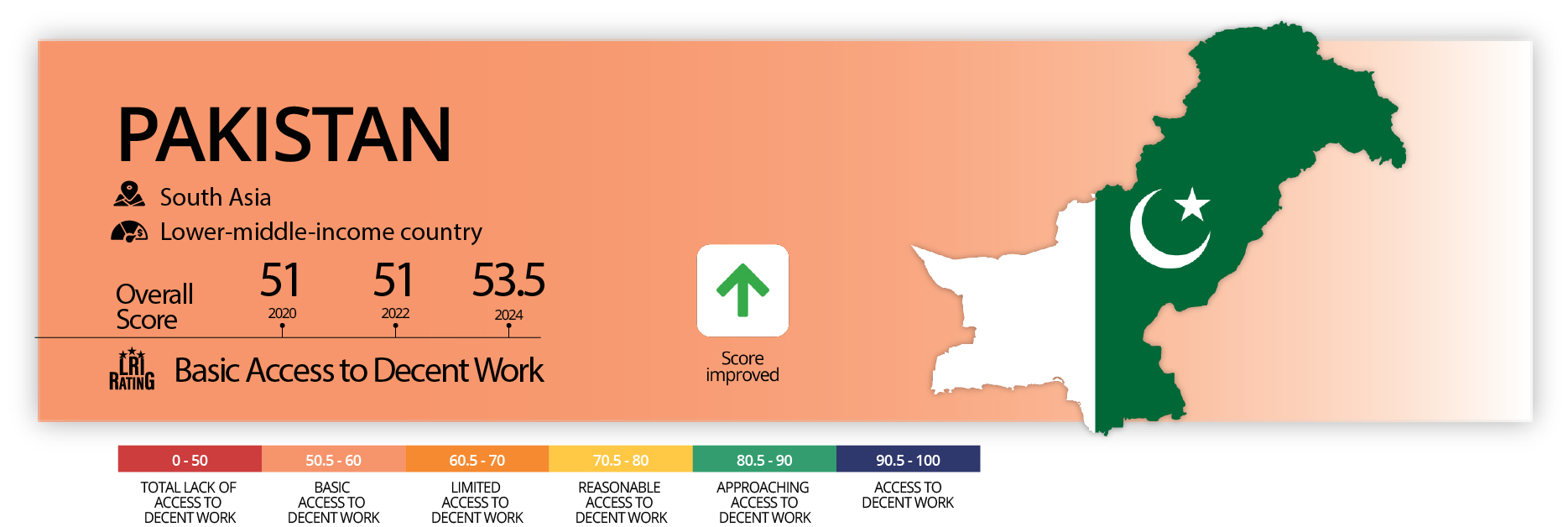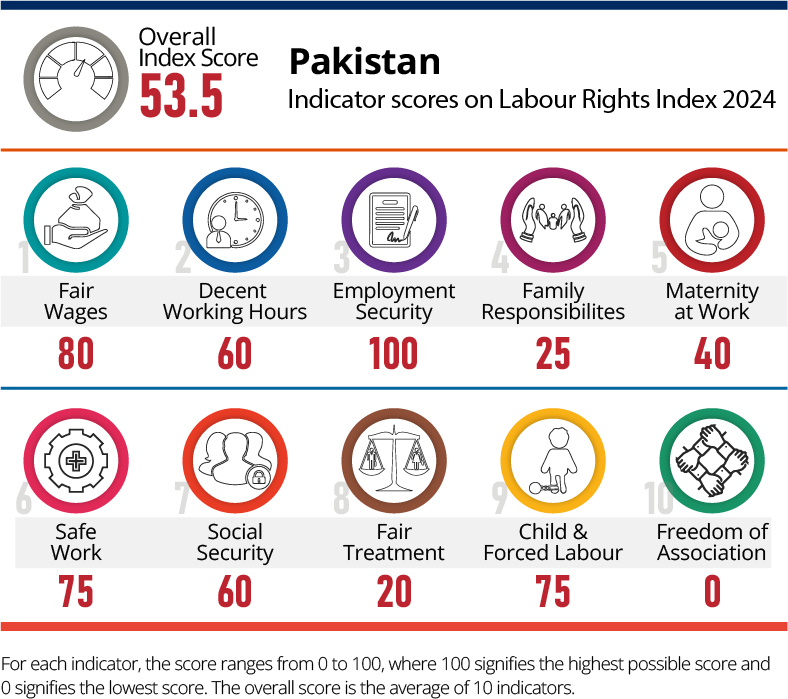How to Read the Country Profiles
The Country Profiles section shows a two-page profile for each of the 145 countries covered in the Labour Rights Index 2024. The country profiles are informative about the major aspects of labour legislation in an economy.
Performance Overview
In this section, the performance of a country in the Labour Rights Index is illustrated. On the top right of the page, the overall average score (out of 100) and rating (out of six categories) give a snapshot of a country's standing in the Labour Rights Index. The top right of the page also shows the overall score in 2020 and 2022, along with region and income group information.
The overall scores benchmark countries with respect to regulatory best practices, as identified in the relevant ILO Conventions, thereby indicating the proximity to the regulatory standard on each component. Each country is allocated ratings according to its overall score. The ratings follow a certain coding; [90.5-100] Access to Decent Work (Blue), [80.5- 90] Approaching Access Decent Work (Green), [70.5-80] Reasonable Access to Decent Work (Yellow), [60.5- 70] Limited Access to Decent Work (Orange), [50.5- 60] Basic Access to Decent Work (Peach), [0-50] Total Lack of Access to Decent Work (Red).
The Contextual Indicators of the country provide a picture of the economy and its labour force at a glance. These facts include Population, Labour Force, GDP per Capita, Poverty Headcount, Informal Employment, Total Fertility rate, Trade Union Density, Collective Bargaining Coverage, Social Protection Coverage, Labour Income Share, Female Labour Force (absolute number and participation rate), Non-Standard Employment (Part-Time Employment-A and Temporary Employment-B), Work Injuries (Fatal and Non-Fatal), Minimum Wage, and number of Workers per Labour Inspector. The contextual indicators have been sourced from International Labour Organization, World Bank data, and the Wagelndicator's own Minimum Wages Database.The country scores on the Labour Rights Index must be interpreted with caution, considering also the above referred contextual indicators.
The first page also introduces the Index and gives information about the average regional score and the highest scoring country in the region.
The overall score and each of the indicators are shown on the first page. For each indicator, the score ranges from 0 to 100, where 100 signifies the highest possible score and 0 signifies the lowest score. The overall score is the average score of 10 indicators. To read about the scoring methodology, refer to the chapter on Indicators for Decent Work.
The next three pages of the country profile shows the decent work indicators of the Labour Rights Index and the answer for each component, along with its legal basis. It is a step toward ensuring greater transparency in the scoring of the countries. The last column shows the trend over the previous two years (2022 to 2024); if the score increased due to a positive reform, it decreased due to a legislative reform or if the score was adjusted to increased availability and access to more legal information about the country. A total of 46 components are shown under the 10 indicators for each of the 135 countries in the Labour Rights Index.
The last page of the Index has necessary end notes and colour legends to explain the changes in country scores.
Sample Country Profile - Pakistan
Country profiles for all 145 countries are available for download on http://labourrightsindex.org/

The country rating is based on the overall score of 0-100, with the following coding: The overall score ranges from 0 to 100, where 100 signifies the highest possible score and 0 signifies the lowest possible score. The score indicates “access to decent work” by law.
Contextual Indicators

At a glance
For Pakistan, the labour legislation in the most populous province (Punjab, Pakistan) is analysed and scored. Different rules may apply in other jurisdictions, necessitating review of other sources.
Following this approach, Pakistan’s overall score is 53.5 out of 100. The overall score for Pakistan is lower than the regional average observed across South Asia (57). Within the South Asian region, the highest score is observed for India (65).
Punjab, Pakistan has implemented 7 calendar days of paid paternity leave for fathers, enhancing support for new parents and promoting a balanced approach to family responsibilities. The paternity leave is however available only for two children.
The country scores on the Labour Rights Index must be interpreted with caution, considering also the contextual indicators like the size of the population and labour force, informal employment in the country, social protection coverage, level of economic development (as measured by GDP per capita), female labour force participation rate, incidence of non-standard
employment in the form of part-time employment and temporary employment as well as work injuries, both fatal and non-fatal. Trade union density and collective bargaining coverage rates are also relevant contextual indicators to assess the state of
freedom of association and collective bargaining in the country.

About Labour Rights Index
The Labour Rights Index 2024 (LRI 2024) is a de-jure index covering 145 economies and structured around the working lifespan of a worker. In total, 46 questions or evaluation criteria are scored across 10 indicators. The overall score is calculated by taking the average of each indicator, with 100 being the highest possible score. The Index uses a rating system, ranging from “Total Lack of Access to Decent Work” to “Access to Decent Work”. The Labour Rights Index aims at an active contribution to the Sustainable Development Goals, by providing necessary (complementary) insights into de jure provisions on issues covered in particular by SDG 5 (Gender Equality), SDG 8 (Decent Jobs), SDG 10 (Reduced Inequalities) and SDG 16 (Strong Institutions). The Labour Rights Index scores countries based on applicable labour laws only. It does not comment on actual working conditions or labour law compliance in workplaces. The legislation that is used to score the country under the Labour Rights Index is generally national or federal level legislation. In cases where the legislation is enacted at the provincial/regional or state level, the Index analyses the labour legislation applicable to the most populous province/region or state (in federal, confederal or other complex structure states). Scoring for each country is based on labour legislation, as applicable on 1 January 2024.
In order to measure the trend in country’s legislative performance over the last edition of the Labour Rights Index (2022), the opposite legend is used.


- Proportion of population living below the national poverty line (%), as measured under the SDG 1.2.1
- Share of informal employment in total employment (%), as measured under the SDG 8.3.1
- Proportion of the country population covered by social protection floors, as measured under the SDG 1.3.1
- The female labour force is shown in absolute number (A) along with the female labour force participation rate (B)
- Non-Standard Employment has been defined as part-time employment (A) and temporary employment (B)
- Rate of fatal (A) and non-fatal work injuries (B) per 100,000 workers, as measured under the SDG 8.8.1
- Minimum Wage and Living Wage amounts are shown in local currency. The amounts are retrieved from the WageIndicator Minimum Wage Database and the WageIndicator Living Wage Database. The minimum wage amounts are those as were applicable on 1 April 2024. The Living Wage amounts are from the April 2024 data release by the WageIndicator. Given the declining share of labour income (a widely used measure of inequality, measuring the proportion of total income in a country that employed people earn by working), the contextual indicators on minimum wage and living wage are relevant.
- Robust legislation, backed by effective enforcement, forms the foundation for achieving decent work in practice. In this regard, it is relevant to see if the country has an adequate number of labour inspectors. While the Labour Inspection Convention, 1947 (No. 81) calls for a “sufficient number” of inspectors to do the work required, there is currently no official definition for a sufficient number of inspectors. In its 2006 General Survey on Labour Inspection, the ILO referred to the following benchmarks on the number of labour inspectors in the country in relation to the labour force: 1:10,000 in industrial market economies, 1:15,000 in rapidly industrializing economies, 1:20,000 in transition economies, and 1:40,000 in less developed countries. The latest guidance from the ILO (2022) however emphasizes a more holistic evaluation of national context rather than solely a ratio of labour inspectors to the size of labour force.
- The Living Wage estimates shown in this country profile are for a typical family (lower bound) that comprises two adults. The number of children is determined by the country-specific fertility rate, representing the average number of children in a family. One adult is engaged for 100% of normal working hours, while the working hours of the second adult are approximated based on the national labour force participation rate. The combined wage earned by two adults, each receiving a living wage, is designed to meet the requirements for achieving a decent standard of living for the family. For further details on this, please check here: https://wageindicator.org/salary/living-wage
- The prohibited grounds for discrimination are “race, colour, sex, religion, political opinion, national extraction or social origin, age, disability and trade union membership”. A score of 1 is assigned only if a country has prohibited discrimination on at least 7 of the above 10 grounds.
- The Freedom of Association indicator of the Labour Rights Index uses Observations/Direct Requests from the ILO Committee of Experts on Application of Conventions and Recommendations (CEACR), the US Department of State’s Country Reports on Human Rights Practices (USDOS CRHRP) and the country’s legal profiles under the ITUC Global Rights Index 2024 to measure a country’s compliance with the right to freedom of association and collective bargaining. A country’s score on the LRI’s Freedom of Association indicator must also be read together with the SDG indicator 8.8.2, which measures the level of national compliance with labour rights (freedom of association and collective bargaining) based on ILO textual sources and national legislation. It has a range from 0 to 10, with 0 being the best possible score (indicating higher levels of compliance with FACB rights) and 10 the worst (indicating lower levels of compliance with FACB rights). The score for Pakistan on the latest available data of the SDG 8.8.2 is “4.85” (2022). Other than SDG 8.8.2, we suggest considering the country's score on ITUC’s latest Global Rights Index. The score for Pakistan in 2024 is “5”. As explained by the ITUC, “Countries are rated in clusters from 1-5+ depending on their compliance with collective labour rights, with 1 being the best rating and 5+ the worst rating a country could get. A high-rated cluster means that workers in the country have no right to their collective voice due to government failure to guarantee rights”.
- In order to measure the trend in country's legislative performance over the last edition of the Labour Rights Index (2022), the legislative table indicates improvement or worsening of de-jure labour rights in country through the following colours.
